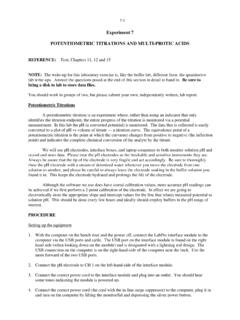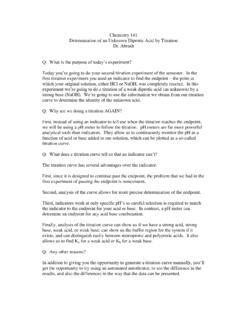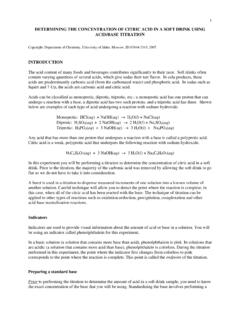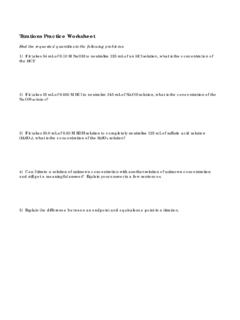Transcription of Experiment 6 Titration II – Acid Dissociation Constant
1 6-1 Experiment 6 Titration II acid Dissociation Constant Introduction: An acid /base Titration can be monitored with an indicator or with a pH meter. In either case, the goal is to determine the equivalence point of the Titration . This is the point at which enough titrant has been added to the analyte to just exactly neutralize the analyte. In this Experiment , knowledge of the equivalence point will be used to obtain information about the acid Dissociation Constant , Ka, of the acid being titrated. When an indicator is used in a Titration , the color change occurs at what is called the endpoint. If the indicator has been properly selected, this point will be the same as the equivalence point. When a pH meter is used, the pH of the solution is recorded as the titrant is added.
2 The pH versus the volume of titrant added can be plotted on what is called a Titration curve. In this case the equivalence point occurs at the point where very small additions of titrant cause a very rapid rise in the pH. Graphically, it is also the point on the curve where the slope, pH/ V, changes from positive to negative (called the inflection point.) Figure 1 is a Titration curve for the Titration of HCl by NaOH, a strong acid and strong base, where mL of M HCl is titrated with M NaOH. NaOH Titration of HCl024681012140 102030mL N aO H adde dp H40 PhenolphthaleinEquivalence Point Methyl RedFigure 1. Titration of mL of HCl by M NaOH. Blocked areas on the curve indicate the pH range in which phenolphthalein and methyl red change colors.
3 Note that the slope, pH/ V, becomes large when the volume of NaOH added is at 25 mL, so this is the equivalence point. Because of this rapid rise through a range of pH values when the equivalence point is reached, a wide variety of indicators may be used to detect the UCCS Chem 106 Laboratory Manual Experiment 6 6-2 endpoint visually. Either methyl red or phenolphthalein can be used for an HCl/NaOH analysis, since both will exhibit color changes in the range of pH values at the equivalence point. Also note that if the slope, pH/ V, is plotted versus the volume of titrant added, the inflection point will appear as a spike. This is the most precise method for determining the equivalence point, and it is shown in Figure 2 below.
4 Slope vs. mL Titrant Added050100150200250202224262830mL NaoHd(pH)/d(V) Figure 2. Plot of slope, pH/ V, vs. mL NaOH from 20 to 30 mL based on Figure 1 Titration . When a weak acid is titrated by a strong base, the fact that, in aqueous solution, the weak acid dissociates into a hydrogen ion and the conjugate base of the acid changes the appearance of the Titration curve. The curve will look similar to Figure 3, which represents the Titration of M acetic acid with M NaOH. NaOH Titration of CH3 COOH024681012140 10203040mL NaOH addedp H Methyl red B AA: Equivalence point B: Half-equivalence point pH at B = = pKaPhenolphthalFigure 3. Titration of 25 mL of acetic acid by NaOH. UCCS Chem 106 Laboratory Manual Experiment 6 6-3 Several differences are readily apparent in the comparison of Figures 1 and 3.
5 There are variations in the initial pH, the rate of pH change, and the pH at the equivalence point. The addition of a strong base to a weak acid creates a build up of the salt of the weak acid (in this case, NaCH3 COO) producing a buffering effect, which causes resistance to change in pH. Also, the pH of the equivalence point corresponds to the pH of the conjugate base, CH3 COO , which hydrolyzes in water. Notice that the endpoint of the methyl red does not occur at the equivalence point, and therefore it could not be used in the Titration . The phenolphthalein is appropriate for this specific Titration . All these effects are related to the strength (or degree of Dissociation ) of the acid being titrated. Because of the incomplete Dissociation of the acid , the reaction is in equilibrium, with an acid Dissociation Constant , Ka, which is specific to that acid .
6 For the Dissociation of any weak acid , HA: HA(aq) H+(aq) + A (aq) there is an acid Dissociation Constant , Ka: [HA]]][A[Ha +=K This can be rearranged to solve for [H+]: ][A[HA]]H[a +=K Using the definition of pH, this equation can be rearranged as follows: = = +][A[HA]loglog]Olog[HpHa3K , or +=[HA]][Alog ppH-aK This last expression is known as the Henderson-Hasselbach equation. It can be used to calculate the pKa (and thus Ka) of an acid . At the equivalence point, the volume of base added is just enough to exactly neutralize all of the acid . At one-half of this volume of added base, called the half-equivalence point, enough has been added to neutralize half of the acid .
7 Since half of the acid reacted to form A , the concentrations of A and HA at the half-equivalence point are the same. Therefore, at the half-equivalence point, the pH is equal to the pKa. Sincea-ppH that followsit , 0 log(1) [HA]][Alog K=== . UCCS Chem 106 Laboratory Manual Experiment 6 6-4 A plot of the Titration curve allows the equivalence point to be determined. At exactly one-half the volume of the equivalence point, the measured pH is equal to pKa as illustrated in Figure 3. For polyprotic acids there are multiple Dissociation steps and equivalence points, one for each acidic hydrogen present. The Dissociation reactions of a weak polyprotic acid , H3A, are shown below along with the neutralization reactions that occur in a Titration by a strong base.
8 H3A(aq) H+(aq) + H2A (aq) OH + H3A H2O + H2A H2A (aq) H+(aq) + HA2 (aq) OH + H2A H2O + HA2 HA2 (aq) H+(aq) + A3 (aq) OH + HA2 H2O + A3 Each step has a separate Dissociation Constant : Ka1, Ka2, and Ka3. A Titration curve for a triprotic acid is thus expected to have three equivalence points, but often only shows two. A Titration curve for a diprotic acid , H2A, would show two equivalence points, one in which OH neutralizes H2A and a second in which OH neutralizes HA . The pKa is obtained in the same way as for a monoprotic acid , but in this case at least two half-equivalence points are present. One half-equivalence point occurs at one-half the volume of the first equivalence point, at which pH = pKa1.
9 The second occurs at the volume that is at the midpoint between the first and second equivalence points, and at that point, pH = pKa2. 024681012140 102030405060mL N aO Hp H DC BA A: First equivalence point B: Second equivalence point C: First half equivalence point D: Second half equivalence point pH at C = = pKa1 pH at D = = pKa2 Figure 4. Titration curve of weak diprotic acid by NaOH(aq). Pre-Lab Notebook: Provide a title, purpose, CH3 COOH / NaOH reaction, brief summary of the procedure, and table of reagents (NaOH and CH3 COOH). UCCS Chem 106 Laboratory Manual Experiment 6 6-5 Equipment: 50 mL Buret Vernier pH Probe 250 mL Beakers (2) Vernier LabPro mL Volumetric Pipet TI-84 Calculator mL Pipet and Bulb Stir Bar and Stir Plate DI water Ring stand, buret clamp, clamp for pH probe In-Lab Procedure: Note: Work in pairs.
10 Use the standardized NaOH solution prepared during the last lab period. Set up the Vernier system in DATAMATE according to the Vernier tutorial with the pH probe connected to channel 1. Calibrate the electrode as described in Experiment 4. Part A: Titration of Acetic acid with NaOH Phenolphthalein: 1. Fill the buret with NaOH. Pipet mL of M CH3 COOH into a 250 mL beaker and add 3 4 drops of phenolphthalein indicator. Place the beaker on a white paper towel to best observe color changes. 2. Titrate the solution by adding the NaOH titrant in 1 2 mL increments. Carefully swirl the beaker with each addition. 3. The colored form of the phenolphthalein will begin to stay for a while and then disappear. At this point add the NaOH dropwise until the acetic acid is a very light color.







